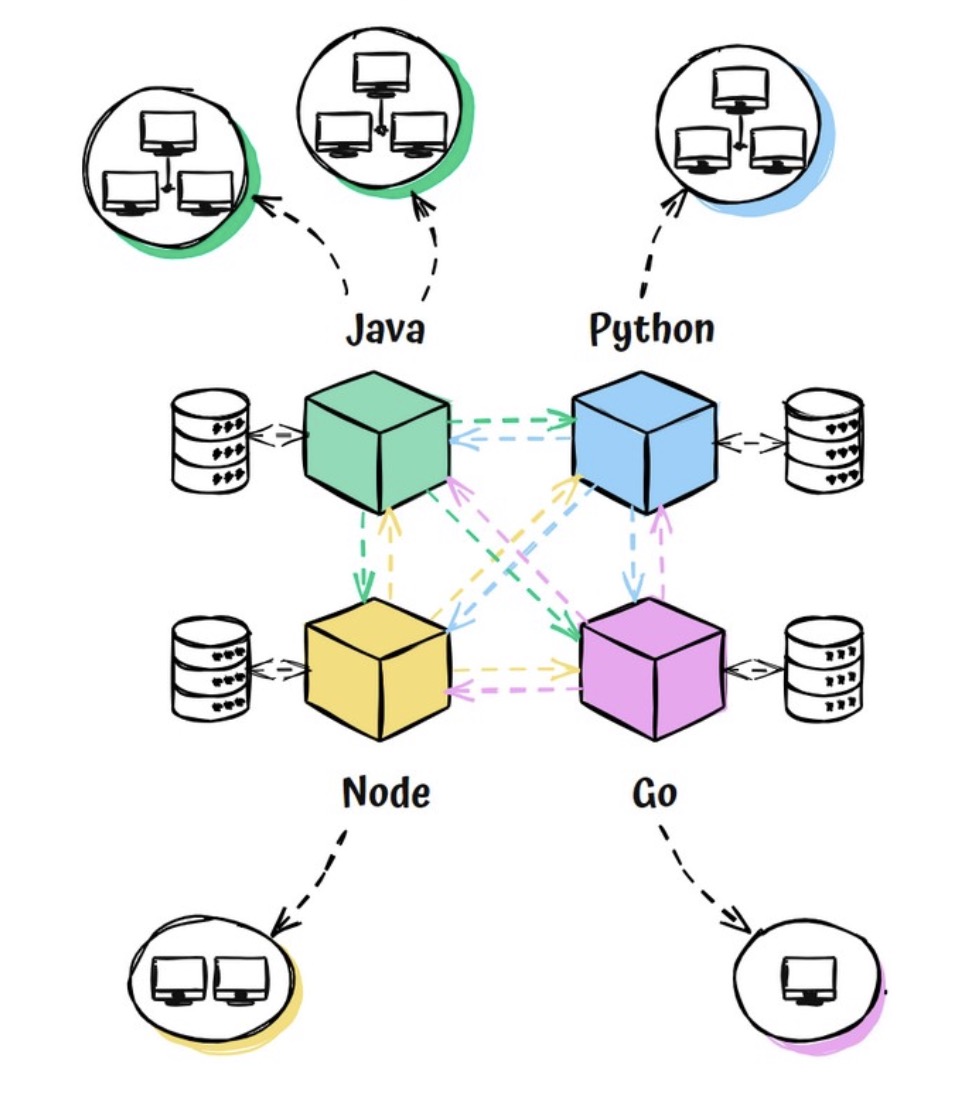What are the Challenges faced in Microservices Architecture? #

- Scaling: Scaling individual components independently
- Service Discovery: Dynamically locating services in a distributed system
- Load Balancing: Distributing traffic among service instances
- Resiliency: Handling failures
- Release Management: Managing frequent releases
- Configuration Management: Maintaining different configurations for environments
- Security: Managing secrets, authentication, and authorization across services
- Monitoring and Logging: Collecting logs/traces across many services
Why is Kubernetes important for DevOps and Microservices? #
What is Kubernetes?
- Definition: Kubernetes is an open-source container orchestration platform
- Goal: Automate deployment, scaling, and management of containerized applications
- Origin: Originally developed at Google, now maintained by CNCF (Cloud Native Computing Foundation)
How Does Kubernetes Work? (High-Level View)
- Create a Cluster - For example: Master Node + 4 Worker Nodes
- Deploy Microservice A - For example: 3 instances
- Microservice A instances will be distributed across worker nodes
- Deploy Microservice B - For example: 4 instances
- Microservice B instances will be distributed across worker nodes
Why is Kubernetes Important for DevOps?
- Standardized Infrastructure: Provides a uniform platform for deploying microservices regardless of language or framework
- Standardized Automation of Deployment & Scaling: Helps DevOps teams deploy and scale apps automatically
- Environment Consistency: Ensures consistent behavior across dev, test, and production
- Supports Continuous Integration & Delivery (CI/CD): Integrates well with Jenkins, GitHub Actions, etc. Easy Rollouts & Rollbacks.
- Supports IaC: Declarative configurations can be stored in Git and managed as code
- Declarative State Management: Define the desired state and let Kubernetes make it happen
- YAML-Based Definitions: Declare deployments, services, configs, etc. in version-controlled files
How Kubernetes Simplifies Microservices
- Service Discovery & Load Balancing: Built-in service abstraction (Built-in DNS and routing) makes service communication simple
- Independent Scaling: Scale individual microservices based on load
- Observability Support: Native integration with logging, monitoring, and tracing tools like Prometheus and Grafana
Kubernetes Enables High Availability and Resilience
- Self-Healing: Automatically restarts failed containers, reschedules on healthy nodes
- Node Failover: Reschedules workloads on surviving nodes during failures
Kubernetes Enables Efficient Resource Utilization
- Isolated Deployments: Each microservice runs in its own pod/container
- Resource Limits: Prevent noisy neighbor issues by defining CPU and memory limits
- Auto-Scaling: Adjust workload based on demand (HPA, VPA, Cluster Autoscaler)
- Cost Optimization: Better resource utilization reduces cloud spend
- Namespaces: Segment environments or teams on the same cluster
Kubernetes is Cloud & Platform Agnostic
- Run Anywhere: Supports on-premises, public cloud (AWS, Azure, GCP), hybrid, and edge
- Avoids Vendor Lock-in: Use the same Kubernetes setup across providers
- Supports Multi-Cloud Strategy: Run distributed clusters across different clouds
What Features does Kubernetes provide? #
- Automatic Scaling: Scales infrastructure and applications up or down based on demand
- Load Balancing: Distributes network traffic to maintain application stability
- Service Discovery: Automatically assigns DNS names to services & manages their IP addresses
- Self-Healing: Automatically restarts failed containers, reschedules them, & kills unresponsive ones
- Automated Rollouts & Rollbacks: Manages application updates with minimal downtime
- Storage Orchestration: Automatically mounts storage systems like local storage, public cloud providers, or network storage
- Secret & Configuration Management: Manages sensitive information & application configuration without rebuilding container images
- Multi-Tenancy: Isolates workloads in namespaces, allowing multiple teams to share a cluster
- Batch & Cron Workloads: Native Job & CronJob objects for one‑off or scheduled batch processing
How can your run Kubernetes? #
| Mode | Description |
|---|---|
| Minikube | Lightweight local Kubernetes dev setup - primarily for learning and building for Kubernetes |
| Docker Desktop (with Kubernetes - macOS/Windows) | Easy local setup for developers; includes built-in single-node Kubernetes cluster; great for quick testing |
| Kind (K8s-in-Docker) | Fast and efficient for CI pipelines or local cluster simulation |
| Self-Managed | Full control over nodes and control plane; requires manual maintenance |
| OpenShift | Extends Kubernetes with additional features and tools to simplify development, deployment, and management of enterprise applications. Offers various deployment options, including self-managed, cloud-based.. |
| Cloud-managed | EKS (AWS), GKE (Google), AKS (Azure); managed control plane, scalable infra |
| MicroK8s | Zero-ops Kubernetes for developers, edge and IoT - production-ready experience with a focus on ease of use and a minimal footprint |
| K3s | Lightweight Kubernetes distribution by Rancher; ideal for IoT, edge, or resource-constrained environments |
Give an overview of Cloud-managed Kubernetes Options? #
-
Cloud-specific services (NOT Kubernetes):
- ECS: Amazon Elastic Container Service, a fully-managed container orchestrator with deep AWS integration
- Fargate: Serverless (ECS or EKS) - abstracts away server and node management so you can focus on workloads or applications
-
Cloud-native Kubernetes offerings:
- EKS: Amazon Elastic Kubernetes Service, AWS-managed Kubernetes service
- AKS: Azure Kubernetes Service, Microsoft-managed Kubernetes service
- GKE: Google Kubernetes Engine, Google Cloud's Kubernetes service offering both Standard and Autopilot (serverless) modes
-
Multi-cloud & hybrid platforms:
- Amazon EKS Anywhere: Extension of EKS that lets you deploy and operate Kubernetes clusters on-prem or in other clouds
- GKE Enterprise: Extend GKE to work in multiple environments, including on-prem, AWS, Azure, ..
- Azure Arc-enabled Kubernetes: Brings Azure capabilities to Kubernetes clusters outside of Azure — including on-premises, AWS, Google Cloud,..
How does Kubernetes Release Cycle work? #
- Semantic Versioning: Kubernetes versions are expressed as x.y.z, where x is the major version, y is the minor version, and z is the patch version
- Example: 1.33.2
- Release Cadence: Currently the project targets ~3 minor releases per year (every 4 months)
- Feature Phases: New features progress through alpha (testing), beta (more stable but evolving), and GA (General Availability - fully stable) stages
- Support Window: Each minor release currently receives patch & security updates for ~12 months
- Patch Releases: Issued as needed between major/minor releases (e.g., security or CVEs, critical bug fixes)
- Explore Release History: https://kubernetes.io/releases/